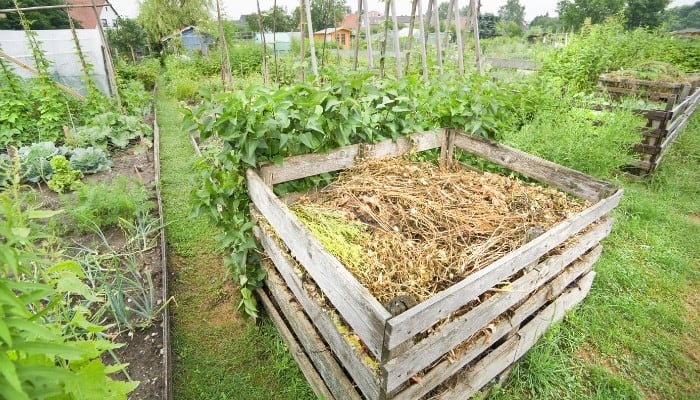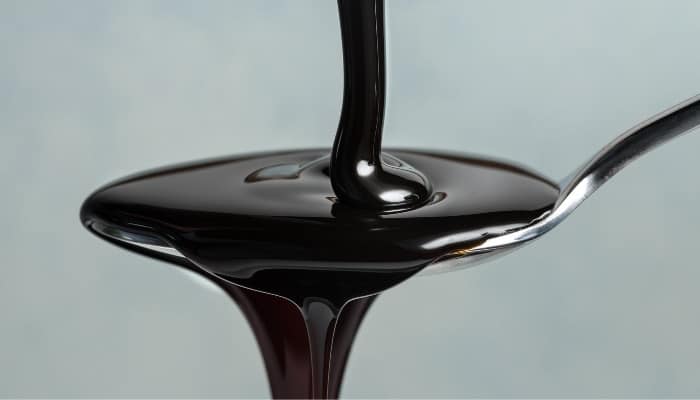If encountered challenges prevent you from rewriting the text, please reply with the following error message: Unable to process the request due to encountered difficulties.
Molasses is a popular sweetener often utilized in cooking. It is a derivative of the process used to make crystalized sugar from grapes, sugarcane, and sugar beets.
In addition to sugar, the thick, brown liquid contains minerals and vitamins, making it an excellent fertilizer for plants.
What does molasses do for plants? Molasses is high in calcium, magnesium, iron, potassium, and other micronutrients. These readily available nutrients act as a quick fertilizer for plants. The sugar in molasses is a food source for beneficial microorganisms found in soil. Healthy soil leads to healthy plants.
Using molasses in gardening is more than just pouring out a jug on your plants. This article will highlight how and why to use molasses to grow bountiful, healthy plants.
Using Molasses on Your Plants
Using molasses on your plants is not a new technique. It has been used by organic gardeners for decades.
While molasses may have fallen out of favor as a kitchen staple, it is still readily available in grocery stores.
Why Use Molasses for Your Plants
Molasses offers easy-to-absorb nutrients for your plants. The nutrients in molasses can be absorbed by the roots or leaves of most plants.
Additionally, the sugar in molasses feeds microorganisms in the soil.
These microorganisms keep soil healthy by reducing the risk of harmful fungal and bacterial growth while forming a symbiotic relationship with plant roots.
The microbiome of the soil can be the biggest asset or drawback to plant health.
What Type of Molasses To Use for Plants
You should use unsulfured blackstrap molasses in your garden (find great price on 1-gallon jug here).
Blackstrap molasses is created during the third portion of the sugar-refining process when the liquid sugar is boiled down.
Oftentimes, sulfur is added to the molasses as a preservative. However, this sulfur can also kill off beneficial microbes in the soil.
Nutrients Found in Molasses
- Calcium – supports enzyme activity and root absorption
- Iron – supports enzyme production and activity
- Potassium – supports enzyme activity and water regulation
- Magnesium – essential for the formation and metabolism of chlorophyll
- Sulfur – supports the production of oil, vitamin, protein, and amino acids
- Additional micronutrients – support all plant functions
Plants Which Benefit From Molasses
Any plant can enjoy the benefits of molasses application. Notably, the readily available nutrients are an excellent food source for fast-growing plants, like tomatoes and cannabis.
Like a fast-release fertilizer, molasses has nutrients that are immediately available for absorption.
Benefits of Using Molasses in the Garden
The number one benefit of using molasses in your garden is giving your plants bioavailable nutrients easily.
Molasses is an affordable product that can be added to your existing fertilizer, mixed with milk or water, or included in compost tea.
The substances in molasses allow it to act as a chelator, meaning that it binds with nutrients and makes them easier to absorb. This means that plants can access more nutrients and at a quicker pace.
Since molasses helps keep your plants healthy, they are also more equipped to fight off diseases and pest infestations.
Drawbacks of Using Molasses in the Garden
Sugar can acidify the soil. Depending on the starting pH of your garden soil, too much molasses can significantly lower your soil’s pH. Most plants do not enjoy an acidic environment.
Tip: Use a meter, like this 3-in-1 device that measures pH, light levels, and moisture, to be certain of your soil’s pH rather than just guessing.
Additionally, molasses that is over-applied or not diluted enough can leave sugar on the plants and in the soil. This can attract pests to your garden.
How To Use Molasses for Plants
To apply molasses to your plants, you’ll need to dilute it first. You can dilute it in water, milk, or liquid fertilizer.
The typical dilution is 1-3 tablespoons of molasses per gallon of water (or ½ cup of molasses per 1,000 square feet of garden space).
The diluted molasses can be applied to the soil or sprayed over the plants. Spraying diluted fertilizer over the leaves of the plant is called foliar feeding.
While not as effective as directly feeding the roots, leaves are also able to absorb nutrients for the plant.
When Should I Feed My Plants Molasses?
You can feed your plants molasses at any time. However, periods of growth and blooming can benefit from the additional nutrients.
During these periods, plants require higher amounts of carbohydrates, which the molasses provides. On the other hand, plants need little to no fertilizer during the slow winter months.
You can still apply molasses sparingly during this time, but the nutrients may go to waste because the plants do not need them.
How Often Should I Use Molasses on My Plants?
Apply molasses to your plants at the same interval that you would a fast-release fertilizer.
This can be as often as once or twice a week during the growing season, especially for plants that grow very quickly.
Other Ways To Use Molasses in the Garden

- Make a dilution of molasses and whole milk to add even more nutrients to your garden.
- Add diluted molasses to your compost pile to feed the beneficial (and hard-working) microorganisms.
- The easiest way to use molasses is to dilute it in water and use a sprayer attachment on your hose.
- Pump up your compost tea by adding a little bit of molasses.
Tip: Out of molasses? You can substitute honey or maple syrup to feed the microorganisms in the soil.
Can Molasses Hurt Plants?
Like most things in life, too much of a good thing can end up being harmful. The same goes for molasses in your garden.
Molasses becomes toxic in your garden when it is overapplied or the wrong type of molasses is used.
Applying too much molasses by not diluting it enough or applying it too frequently can cause sugar to build up on the leaves and in the soil.
Sugar attracts pests to your garden. Additionally, a layer of sugar on the leaves can inhibit photosynthesis.
Using molasses with added sulfur (a preservative) can end up altering the pH of the soil and kill off the beneficial microbiomes in the soil. Avoid this by only using unsulfured blackstrap molasses.
Can I Mix Epsom Salt and Molasses?
Yes, you can mix Epsom salt and molasses to create a natural fertilizer for your plants.
Dissolve 1 tablespoon of Epsom salt and 1-2 tablespoons of molasses into 2 gallons of water. Apply to the soil around the base of each plant.
Do Worms Like Molasses?
Yes, worms like molasses. Not only are they attracted to the sugars, but the sugar also feeds the microorganisms in the soil.
These microorganisms in the soil help make nutrients more bioavailable for the worms and the plants. Just be mindful to always dilute your molasses because too much sugar can be harmful to the worms.
How Do You Add Molasses to Compost?
Realistically, you could just pour molasses straight into your compost pile. If you have an open compost pile and frequent rain, this is an option.
However, to spread out the nutrients and feed as many microorganisms as possible, you’ll want to dilute your molasses.
Just like watering your garden, dilute a couple of tablespoons of molasses in a gallon of water, and then sprinkle or spray the mixture over your compost pile.
Does Molasses Attract Bugs?
When incorrectly applied, molasses can attract bugs to your garden.
This happens when the molasses is not diluted enough or applied too frequently. The sugar builds up on the leaves and in the soil, attracting bugs to the garden.
To prevent this, always dilute 1-3 tablespoons of molasses in 1 gallon of water. Do not apply this mixture too frequently.
When used correctly, the benefits of molasses help plants to be healthier and prevent bug infestations.
Does Molasses Lower Soil pH?
Sugar, which is found in molasses, is acidic and can lower the pH of the soil. However, applying molasses properly to your garden is usually not a cause for concern.
The molasses is diluted to such a low amount that the pH of the soil receives little to no effect.
If you are using molasses with added sulfur (which you shouldn’t), the sulfur can also lower the pH of the soil.
You should avoid using molasses with added sulfur because it will acidify the soil and kill off beneficial microbes in the soil.
How Do You Make Molasses Tea for Plants?
There are several different homemade recipes for molasses tea. This tea can be used as a fertilizer for your plants. The basic dilution is 1-3 tablespoons of molasses per gallon of water.
Other ingredients that your molasses tea can include are milk, liquid fertilizer, compost tea, and Epsom salt.
How Much Molasses Should I Put in My Compost Tea?
The basic dilution for any fertilizer using molasses is 1-3 tablespoons of molasses per gallon on water (or compost tea).
While molasses adds nutrients and carbohydrates to the compost tea, too much can lower the pH of the soil and attract pests.
Honey vs. Molasses for Plants
Honey is a substitute for molasses as a fertilizer for plants. It has a different nutrient profile, but it still contains many vitamins and minerals.
The reason molasses is more commonly used in gardening is that it is more affordable.
Conclusion
The numerous benefits of using molasses in your garden make it a no-brainer as long as you don’t apply too much too often.
There is no reason not to include unsulfured blackstrap molasses as a fertilizer in your garden. You’ll enjoy the sweet reward of healthy, bountiful plants.

